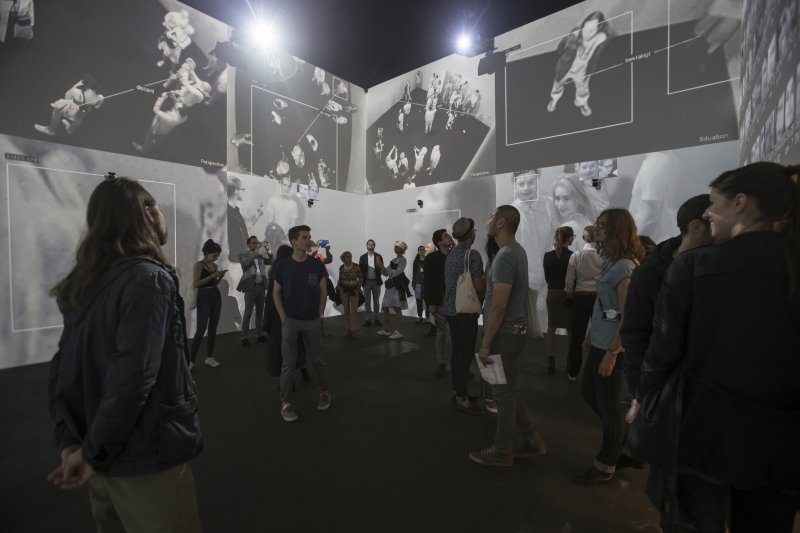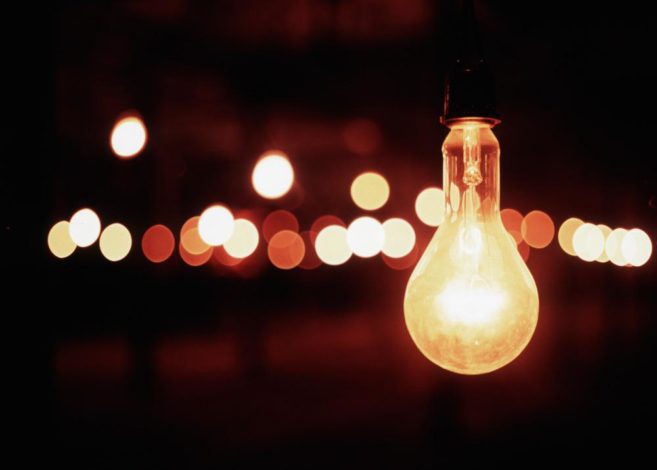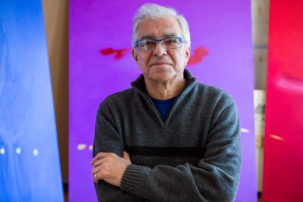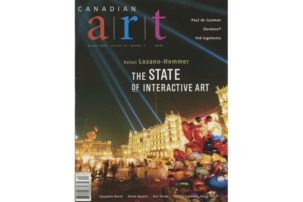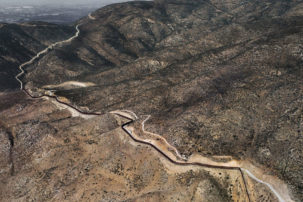Biometric scanners. Face-recognition algorithms. Computerized surveillance tools. Portable heartbeat trackers. Before these elements became a conscious part of everyday life, they were part of the art of Montreal-based creator Rafael Lozano-Hemmer. Now, it seems, much of the world has caught up with the insights Lozano-Hemmer explored in early pieces like 1992’s Surface Tension—a piece in which an image of a giant human eye follows the observer with Orwellian precision. But Lozano-Hemmer, and his art, is still moving forward. A survey of his prescient practice—in fact, his largest-ever solo show in the US and Canada—just opened at the Musée d’art contemporain in Montreal. Called “Unstable Presence,” the new show includes past works like Call on Water, which unspools his uncle Octavio Paz’s poetry in evanescent water vapour, as well as challenging new works, too. Here, in a condensed phone interview, Lozano-Hemmer talks about what brought him to Canada, who continues to inspire him, why language in public art matters, and where he is going next.
Q: You show a lot, and you show a lot internationally. What does this particular survey show mean to you—especially given that it is in Montreal, where you now live?
A: The works are mostly pieces been created over the past 15 years, and that dovetails nicely how long I have been in Montreal. So it really is a panorama of pieces which have been produced here in my studio.
And I have to admit—I didn’t think this would be the case, but it is —I do feel special about [this show]. Because my team of architects and designers and programmers live here and this is our home.
I am from Mexico City. I am married to a Montrealer; we used to live in Spain, and we had kids and decided to move to Montreal to be close to her family.
But I have gotten many good opportunities to make my artworks efficiently here—Montreal is actually a really good city for development of the kind of works that I do, that have different media and computing integrations.
My studio is in the Plateau in the Berman Building—which is a building that also houses other composers and artists and architects. And I benefit very much from that, because, for instance, my neighbours downstairs are industrial designers with whom I work. To the left is Pierre Fournier, a sculptor who helps us make steel objects, and across the hall is Patrick Watson, a musician I find really inspiring.
The studio and the Berman Building is something I am really grateful for. My work requires hustle and bustle of a building such as this one—not solitude in front of a canvas.
Q: There’s always a lot of technical problem-solving that you and your team have to do. What was hardest work in this show to make and why?
A: I would single out two works. They are both brand-new pieces.
Sphere Packing: Bach is a spherical room 3 metres in diameter which has 1,128 loudspeakers, each of which plays a different composition by Bach. All of the speakers are pointed at the centre of the room and they fire the totality of his life’s work onto the public.
It’s very strange kind of sound sculpture, because on the one hand you have industrial design—a very elaborate frame of maple and aluminum—and on the other hand you have electronics—to play out 1,128 simultaneous sound channels is not a trivial problem.
Then, there is another problem that is archival. Most orchestras play the same 100 or 200 compositions by Bach. But we needed to find the full 1,128, the totality. The sound equalization was another issue.
The other work that is also technically challenging is a 3-D printed “speech bubble.” We worked with three universities in the United States on this one.
Whenever you speak, there is air that comes out of your mouth, and this air creates turbulence in the atmosphere. In Aztec or Mayan art you have these kinds of turbulent images of breath.
What we did with these three universities was we used laser tomography that allowed scientists to scan the density of spoken air and detect what what the “shape” of a spoken word might be. It’s different for different people at different times, even for the same word.
Then we 3-D printed some of those words in aluminum—specifically the words “Au claire de la lune.” That’s what’s in the Montreal exhibition.
So we made a sculpture. But the scientists we worked with published papers about the process, because the way breath moves affects infectious disease transmission and other phenomena.
I love that this research had uses that were more scientific, but that for us the artistic gesture was around this stubborn and impossible desire to capture words in form that is unchanging.
Q: Interactive technology has changed a lot since you started out. How do you think it has changed most?
A: I would say that the biggest piece of news is the normalization of that technology.
When I started 25 years ago making interactive art, the world of tracking and biometrics was not as widespread as it is now. The fact that now we carry phones that do GPS tracking, and the fact that these phones have cameras and microphones and speakers, is of course a quite different level of mediation than a few years ago.
I feel now it’s more normal that these technologies are part of ourselves. And in terms of art now, the way I see it is that working with technology is inevitable—working with technology is, in fact, studying ourselves.
Q: Who are your own favourite artists right now?
A: It’s difficult to say. Today it is this person; tomorrow is it someone else.
Probably Agnes Martin is one. She was an incredible inspiration. I’m trying to learn to have a restraint and an economy in my expression, and she certainly embodies that. There’s also something about Martin’s systematic application of instructions onto a final canvas that I love. And I love this idea of a decentralized work, a field that extends.
Marta Minujin is another incredible artist. In 1964, in Buenos Aires, she used live cameras to capture the public and combine it with live TV. The reason I love to talk about her is that the first use of closed-circuit TV in art was not just Nam June Paik, and it was not just Dan Graham. It was this Latin American woman.
It was great to see Minujin just did a piece at Documenta. It’s exciting that pioneers like her are getting their place in history, and people like Lynn Hershman Leeson.
Q: Earlier this year, you and I spoke about the Toronto Transit Commission’s shutdown of a commissioned work of interactive art by Berlin’s Realities:United at a Canadian subway station. The transit authority wanted a “whitelist” or “blacklist” of terms the public could use in that artwork, and the artists wanted no such lists. Can you tell me more about your views on censorship, public art, and interactive work?
A: My work, which is participatory and interactive, has never been censored—and I will never allow it to be censored.
The moment that you censor something, then that’s all the artwork is about—from that moment on, it is all about curtailing expression.
Censorship is what people like Erdogan in Turkey use to create an environment of control. Censorship is also about this desire to impose on people a set of values that are not necessarily universal. Censorship is a way to supress diversity and to mis-educate publics on their responsibility to self-moderate.
Here’s an example: Four years ago, I did a project in Park Avenue Tunnel in New York. And as part of that project I met with the NYPD. The police department told me we should have a six-second delay on the participatory audio, in case someone said something “objectionable” and they could delete it. And I said, “It is your job to protect freedom of speech.”
In the end, we didn’t put any delay on. The piece was completely uncensored. Because this even if what someone is saying is moronic or sexist or racist, they are responsible for their words.
You cannot preemptively create an artwork that will try to exempt those expressions, because people will always come up with something else to break it.
If, on the other hand, you let people go through with whatever dumb thing they want to do, you will find 99 percent of people are mortified by this. And there are consequences for such participation. We must appeal to people’s self-moderation and maturity.
What they [the transit commission] did in Toronto, I still find despicable and unacceptable and embarrassing.
Q: What’s next for you?
A: During Art Basel, starting June 10, I’m doing a transformation of a Roman theatre in the Alps, at the Augusta Raurica. It’s a Vitruvian structure, but it is not a ruin—it’s still being used. We are doing a voice activation of this theatre as a public art piece.
Then, on June 22, we open a commission of a memorial in Mexico for 19th-century poet Ignacio Ramirez. It’s opening on the 200th anniversary of his birth.
Further on, in the fall, I have a solo show at the Hirshhorn in Washington—the entire second floor.
And then, at the end of October, I’m making a bi-national artwork that will interconnect the cities of Ciudad Juarez in Mexico and El Paso in Texas. People will control powerful searchlights with their voices, and penetrate the airspace of the other country.
Rafael Lozano-Hemmer’s “Unstable Presence” continues until September 9 at the Musée d’art contemporain de Montréal. It will travel to Museo de arte contemporanéo de Monterrey in 2019 and to the San Francisco Museum of Modern Art in 2020.

